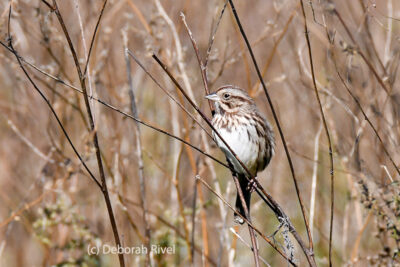
How about a relaxing cleanup this fall? Instead of raking up all those leaves and trimming off berries and old flowers during your fall clean-up, do yourself, birds, bees, and butterflies a big favor by doing less. With significant amounts of native habitat loss, our backyards and gardens have become essential habitats supporting all kinds of wildlife including birds, and pollinators. And by not making our yards and gardens spic and span, we preserve a mini-ecosystem that supports all kinds of essential life. So, cut back on the cleanup and you will be doing yourself and the native wildlife in your yard a favor! Below are some additional ways to get your garden ready for winter, have a positive impact on the birds and other wildlife in your area year-round, and improve your garden as a whole
- Keep stems, dried flowers, and berries on plants. The fruit and seeds will provide critical food for birds and other wildlife throughout the long winter months when food becomes scarce. Plus, solitary bees will build nests in dead plant stems and use old woody material like dead branches even those on the ground. Leave those too!
- Keeping everything on the ground helps a lot of wildlife. Fallen leaves are often raked or blown away to make the yard look neat and tidy. But they create crucial habitats for pollinators and should be left alone. The undersides of leaves often contain moth and butterfly eggs, and these same pollinators often shelter under fallen leaves in colder weather. Did you know that bumblebee queens hibernate in shallow holes just a few inches below the soil until spring?
- Fall is the perfect time to remove invasives. With natural die-back, ts much easier to find and remove plants that aren’t native. Many exotic plants like phragmites, Purple Loosestrife or Kudzu can easily take over your garden. Time spent in the pre-winter season removing them will be reflected in the spring with a garden that can thrive without this competition. The safest and best way of removing them is the old-fashioned way – by hand! Herbicides kill more than the plants you want and also put highly toxic chemicals into the soil and water supply.
- If you haven’t already done this, now is the moment to start planting native plant and tree species. Shrubs and trees can be planted as long as the soil isn’t frozen. Planting now gives the plants a head start in the spring. These native plants and shrubs provide critical migratory and nesting habitat for birds, and with the right native plants, can be a butterfly magnet. In winter, they will provide shelter and much-needed sustenance for birds, too.
- Fresh water is crucial for the survival of birds in winter. If you live in an area where water freezes, get a heated birdbath so the water will always be available. Birds dehydrate easily in winter and the availability of fresh open water can be a life-saver. You can get all sorts of heated bird baths – from electrical to those which run on solar power. Find one that makes sense for your space and give that a try. You will discover your yard is extremely popular with this open water source in cold weather.
- Brushpiles provide shelter from the elements and predators year-round. Stack limbs when trimming trees and bushes and put them in a pile that you can add to whenever you do more trimming. During windy days, or snow and rain, birds will hide in there to stay dry and warm. And if your brush pile is close to a feeder, it’s a great spot for the birds you are hosting in your backyard to dash away from predatory hawks. Density is critical, as is height. The base of the brush pile should be limbs and large sticks, but as it grows you can always pile on vines you have removed.
For more information on the best ways to get your yard ready for winter, check out this article on pollinators from Tufts University and more ideas from the Healthy Yards website.